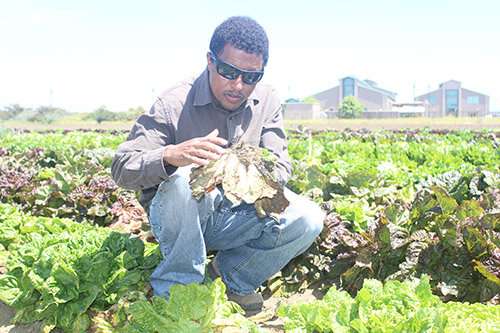Bullo Erena Mamo with lettuce. Credit: Bullo Erena Mamo
Lettuce drop is a lettuce disease that results in browning or wilting of leaves, plant collapse, and death. The disease has not been well-researched, but a new study shows that a stronger stem increases resistance to lettuce drop.
This disease is caused by Sclerotinia spp., one of the most destructive plant pathogens that infects more than 700 plant species around the world. We still don't have a deep understanding of host resistance to this pathogen but scientists in California were the first to observe that the species Sclerotinia minor formed a sclerotia (resting structure) in lettuce stem.
To describe this phenomenon, researchers at the University of California, Davis, and the United States Department of Agriculture–Agricultural Research Service in Salinas conducted additional studies and found differences between modern commercial cultivars and wild lettuce.
"The modern cultivars were susceptible to rapid basal stem and root rot by Sclerotinia minor. Oil-seed lettuce and the prickly wild lettuce were resistant to rot," explained lead author Bullo Mamo, a postdoctoral researcher in the UC Davis Department of Plant Pathology. Wild lettuce species also showed reduced symptom development but sclerotia formation went up to a significantly higher height in their stems.
Infected modern cultivars saw a rapid decrease in photosynthesis efficiency within a day of infection while the wild lettuce species saw no difference. The wild lettuce species also saw an increase in the degree of stomatal opening of leaves within one to three days after infection.
Most importantly, the severity of basal stem rot and stem collapse was low in plants with strong stems. "This indicated that genetic factors associated with stem strength determine the outcome of Sclerotinia infections of the host plant," said Ivan Simko, a senior researcher involved with this study. "We determined that soft stem is a prominent lettuce drop predisposing factor that could be taken into consideration when developing lettuce drop-resistant lettuce varieties through plant breeding."
"Our research demystifies the long-held belief that resistance to Sclerotinia spp. in early bolting host plants is associated with 'disease avoidance.' This work clearly shows resistance in early bolting plants is due to their basal stem strength—which has a genetic underpinning," said Mamo. "Our research also helps explain why commercial lettuce cultivars are usually susceptible to lettuce drop."
This article is the first of its kind to measure and report that stem strength provides disease resistance.These results also serve as the starting point to conduct additional analysis to determine the biological basis of resistance to Sclerotinia spp. in lettuce and other hosts. The article was published in PhytoFrontiers.
More information: Bullo Erena Mamo et al, Epidemiological Characterization of Lettuce Drop (Sclerotinia spp.) and Biophysical Features of the Host Identify Soft Stem as a Susceptibility Factor, PhytoFrontiers (2021). DOI: 10.1094/PHYTOFR-12-20-0040-R
Provided by American Phytopathological Society























